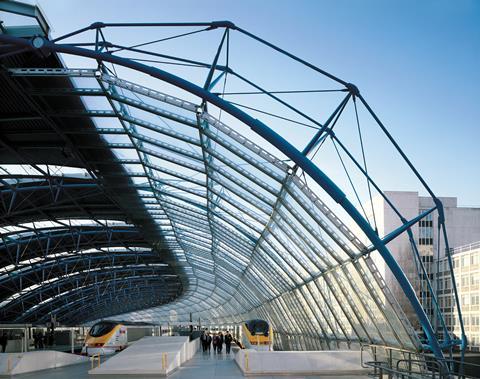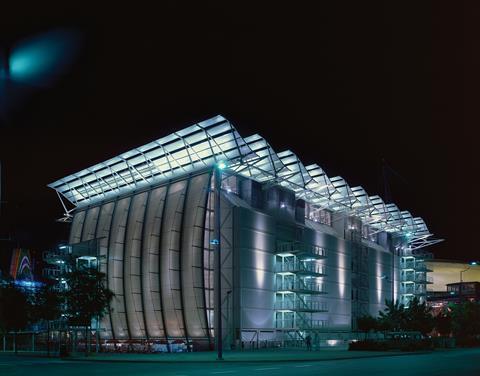Architect nominated by Simon Allford - and backed by Rogers, Foster and Cook

Nicholas Grimshaw has been awarded the Royal Gold Medal at a ceremony at the RIBA’s headquarters at 66 Portland Place.
It is the highest honour for architecture in the UK, presented by the RIBA in recognition of a lifetime’s work, and is approved by the Queen.

The RIBA said Grimshaw was arguably best-known for the landmark International Terminal at London’s Waterloo station and the visionary Eden Project in Cornwall, and that he had played a leading role in British architecture for more than half a century.
The honour was applauded by his peers including Richard Rogers who described his buildings as “outstanding” and Norman Foster who said his work had had “a great impact in defining the post-war era of British architecture”.
Grimshaw graduated from the Architectural Association in 1965. He immediately started in practice and won many awards for his early work.
In 1980 he formed Grimshaw Architects which has won more than 200 awards internationally and employs more than 600 people in eight studios.
Grimshaw, who was elected to the Royal Academy in 1994 and was its president from 2004 to 2011, is still chairman of the partnership.
Sir Nicholas Grimshaw by Simon Allford
I have known Nick Grimshaw since I worked for him in the early 1980s. At this time the practice was well established and known for its pursuit of a particular way of seeing and making buildings. The practice then was only a dozen people but its modus operandi – that has facilitated its growth into a major international practice – was already well established.
The focus then as now was on how buildings should be designed from the outset to respond for the need to change over time in use. The preoccupation was how plan and section could define use, structure and detail to allow for this change. Nick always understood that the life of a building begins once the architect’s engagement ends.

Nick’s particular view on the world thus combines an interest in architecture at the scale of infrastructure, with construction and detail. His focus is on how the technology of new and, wherever appropriate, old materials can work to make an architecture that engages in size (form and silhouettes), detail (celebrating the maker’s mark), energy performance, and long-term capacity for adaptive use. It is this breadth of interest that has made his work both distinguished and of importance to architectural discourse.
The relevance of Nick’s personal response to the challenges of making architecture in the modern era is demonstrated by the fact that his practice has now designed and delivered key projects around the world, all at very different scales and for very different client groups.
Nick’s influence on the profession also extends beyond his work as a practitioner. He has chaired numerous national and international juries for both competitions and awards. He has lectured extensively and around the world, examined and taught widely and is a past president of both the Architectural Association and the Royal Academy. In this latter role he played a key part in garnering the support of painters, sculptors and printmakers, as well of course as the architects, in creating a new facility for, among other things, the permanent display of architecture in the new extension of the Royal Academy at Burlington Gardens [by David Chipperfield Architects].
It is for the reasons listed in the supporting documentation, following my nomination of Nick Grimshaw, I have been able to garner the support of seven Gold Medallists three of whom are also Pritzker Prize winners from both the UK and abroad and a host of other leading architects, artists, writers, critics and clients.

Supporter statements
By Norman Foster
Nick is a friend and a colleague whose work has had a great impact in defining the post-war era of British architecture, and his influence on the international architectural community is undeniable. His architectural outlook is very much based in an honesty towards materiality and structure – like me, he believes that every type of building merits the same care in design. Nick is a Royal Academician and served the academy between 2004 and 2011 as its president with distinction. He was also elected as the president of the Architectural Association, his alma mater, and through his work he has made a distinctive contribution to British architecture, which deserves recognition.
By Richard Rogers
I am delighted to support Simon Allford’s nomination of Sir Nicholas Grimshaw for an RIBA Gold Medal. I’ve known Nick since he was a student at the Architectural Association and followed his career closely. He is an internationally renowned architect and was an exceptional president of the Royal Academy. His buildings are outstanding, from the early residential tower in London to his many transportation hubs around the world. I highly recommend him for an RIBA Gold Medal.
By Peter Cook
Nick was a student of mine at the AA in 1964-5. He was a brilliant student (awarded SADG Medal). Rapidly afterwards he produced projects that were important theoretical and practical markers - the Bathroom Towers, the Metal Apartment Tower near Regent’s Park and the Factory at Bath. Rather than lapsing into ordinariness he continued to do great work.
Certainly, the railway station in Melbourne that I have been to is one of the most poetic and beautiful “high tech” buildings in the world. Using his Waterloo Eurostar terminal frequently, I knew from the first that I was inside something special. At a conference at his Berlin Stock Exchange building – I felt this again. Yael and I regularly drive away from our big local Sainsbury’s to his in Camden Town: we prefer it. He’s a great architect. He deserves the RGM.

















11 Readers' comments